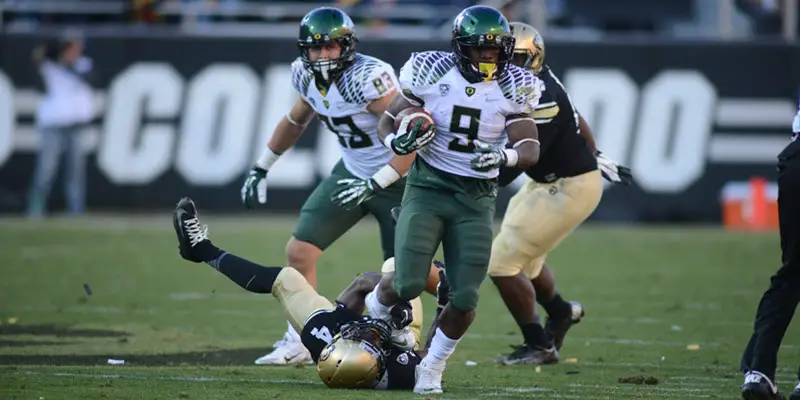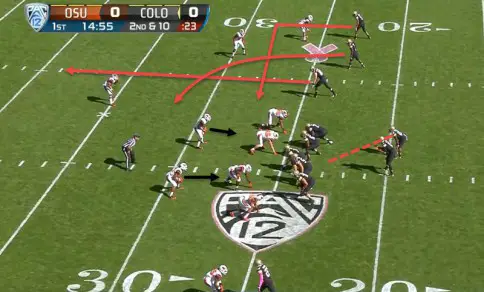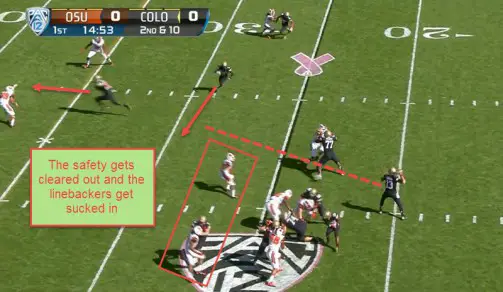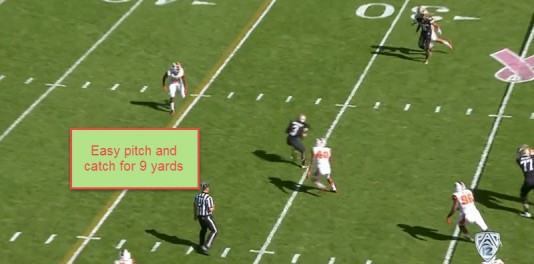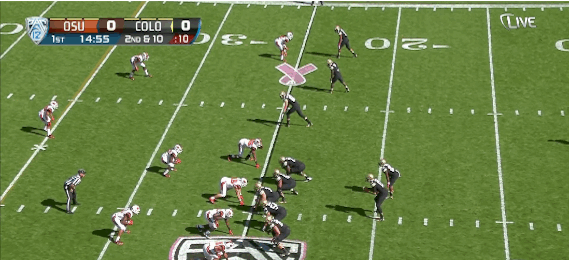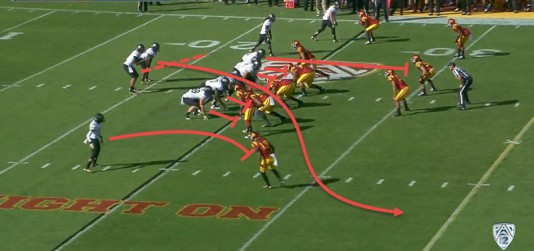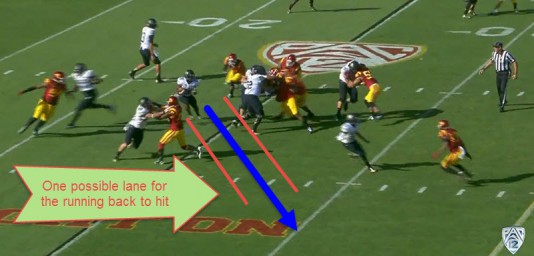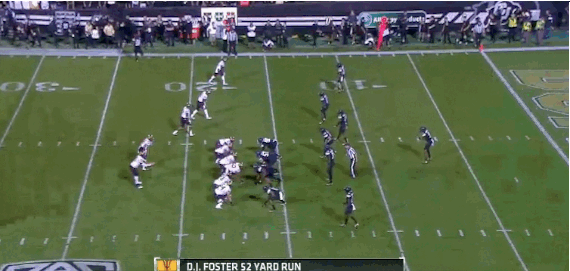Ever since Colorado has become part of the Pac-12, it has been the laughing stock of the league, going only 4-31 in conference play and being outscored by an average score of 43.5-21.5. The fact that Colorado is still without a win in league play, despite having its best team since becoming part of the Pac-12, speaks to just how good the conference is more than being a knock on the Buffaloes.
Colorado even has one of the best receivers in the nation in Nelson Spruce (#22). Spruce started the season insanely hot, averaging 139.4 yards and two touchdowns per game through the first five games, but has cooled down, accumulating a total of only 394 yards and one touchdown since. Don’t let the record fool you, though.
Just ask: UCLA, Cal and Oregon State.
The Buffs have done this with a new west coast-style offense, under second year coach Mike MacIntyre. Let’s take a look at a staple of this offense. The Buffs are lined up in “trips right,” with Spruce lined up on the left with the quarterback in the gun. “Trips right” is when there are three eligible receivers lined up on the right side of the offensive line (above).
Now the concept that this play employs is one that they use a lot; I’m going to call it a clearing route. The inside receiver, in this case the tight end, runs a deep route. The deep route is the clearing route. The clearing route, does what it sounds like it does — it clears space underneath for the other two receivers to run to. If the timing is right, the deep route forces the corner covering the middle receiver, or the #2 receiver, to back off of the receiver, leaving the receiver wide open when he runs an “in” route or a quick slant, as he does in this particular situation.
The final part of the play that makes it successful is the play action aspect. The linemen sell the run so well by going up and blocking the linebackers. This is how linemen normally block on a run play, not a pass play. This clears out more space for the receivers running the underneath routes.
The quarterback now just stands tall in the pocket and waits for his receiver to find an open spot. He then fires it to the receiver for a gain of nine yards.
The Buffaloes often run the outside zone read, similar to our Feathered Friends. As you see (above), Colorado is lined up in trips left, but that doesn’t affect the play too much, so there really isn’t much need to worry about that part.
The read man for Colorado is going to be the defender at the end of the line of scrimmage, as is customary for most read options. So the offensive line is going to leave that defender unblocked and implement a zone blocking scheme.
Now, if the quarterback gives it to the running back, there is not a defined pattern to which hole opens up for the running back. The play (above) will often look like multiple half open holes for the running back to hit — from which he must choose one.

The Colorado running backs are going to be fresh so the Ducks are going to have to be ready to tackle.
This is an odd and risky tactic, but that’s why we are in the stands cheering and not on the field calling the plays. That’s a job for the coaches, because as you can see (below), this play goes for a gain of 18 yards.
Colorado is the epitome of “running back by committee.” There are three running backs with over 300 yards rushing and another with over 200 yards. Although this shows that the Buffaloes don’t necessarily have a play-making back, they have four backs who are able to effectively run the ball, so you can count on the backs being fresh every single carry.
Now, Colorado’s defense is bottom of the pack in the country, giving up 38.6 points per game and 450 yards per game, but as Duck fans might say from experience, stats aren’t everything — Oregon is right there with Colorado, giving up 457 yards per game. This is especially true when you have a potent offense with Mike MacIntyre at the helm and a play-maker like Nelson Spruce at receiver. We will most likely see Colorado run a 4-2-5 defense this weekend (above).
The right middle linebacker and right defensive end take the quarterback. This is not the only job, though, for the right defensive end. Being the read man, he is left unblocked (above). Since he is also faster than most defensive ends, the coaches allow him to go after the running back if the quarterback doesn’t pull it. The left defensive tackle, who is lined up over the center, tries to force the center into the backfield to take away the lane for the running back.
The rest of the defensive line is “eating up” the offensive line. They try to free up their linebackers and nickelback, who are almost solely focused on the run until they are sure it’s a pass play. The free linebackers and nickelback fill the holes and are there for the stop, but in this case, the right defensive end uses his speed and chase down the running back to limit him to a small gain of one.
This Colorado team is not the same team everyone rolled over in the Pac-12 in past years. They are not an automatic win anymore … far from it. Despite this, and despite the Buffaloes’ dangerous play-maker, Spruce, if Oregon prepares properly and doesn’t look past the Buffs to the Civil War next week, this should be a relatively easy win for Oregon. This is no knock on Colorado; Oregon is just playing national championship caliber football. I’d run with a 67-28 victory for our Feathered Friends.
“Oh, how we love to learn about our opponents on FishDuck.com.”
Rory Davidson
Opponent Football Analyst for CFFNetwork/FishDuck.com
Eugene, Oregon
Top photo by Cliff Grassmick
Related Articles:
Rory Davidson: Rory (Football Analyst) is a sophomore at Oregon in the fall (Class of 2018). He has been a devout Stanford football fan since he was 2 months old and is excited about the energy and greatness Oregon sports has to offer. For the past 6 years he has been doing advanced data analytics for his high school football team and working alongside the coaches to understand how they strategize about the game. He wants to integrate more statistics into his analyses and try to help readers learn about and understand the future of sports.

